One of the more exciting events of the month – but outside Paris Photo, the Mois de la Photo and the Photo-Off as it was apparently planned too late to be included – was the latest show of work by Brian Griffin, The Black Country, in the superb setting of the recently renovated 13th century College des Bernadins on the Left Bank of Paris in the 5e. The building is a splendid old religious building and Brian’s show was in its former sacristy, the place where the vestments, sacred vessels, and other treasures were kept. It was a building of impressive size and height and a fine setting for his work.
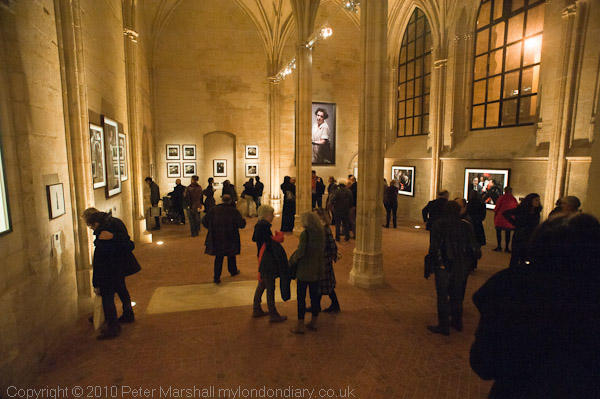
The Sacristy at the College des Bernardins
The Black Country is a work that goes back to Brian’s roots, and to the town were he grew up, Lye, in the Black Country around the north and west of Birmingham. The area got its name from the coal seams close to the surface, and together with iron ore, limestone and clay this made it one of the powerhouses of our first Industrial Revolution. The particular specialities of the region were the making of nails and chains, and Lye itself was “the bucket capital of the world” and there were also brickworks and galvanising plants. The work was heavy and dirty. Many like his father worked in filthy jobs, inhaling dust and other pollutants, absorbing toxic materials through their lungs and their skins. Brian’s father retired in 1983 and died within 18 months, worn out and poisoned by a lifetime of poorly paid factory labour.
Brian’s mother Edith too had a hard life. Her mother had died giving birth when she was only seven and she had been left to care for her younger sister. She worked at a factory a short walk from where they lived, packing nails in boxes and making tea. They lived in a two-up two-down terraced house in a short cul-de-sac, in an area surrounded by factories. Although they had no running hot water, their house was unusual in having an inside toilet, rather than having to go out into the yard at the back. But bath night meant boiling kettle after kettle to fill a small galvanised iron bath with perhaps three inches of water, before each member of the family got in and washed themselves in turn. Brian was lucky as he got first turn. The landlord of their rented home refused to make any improvements or even do repairs to the property.
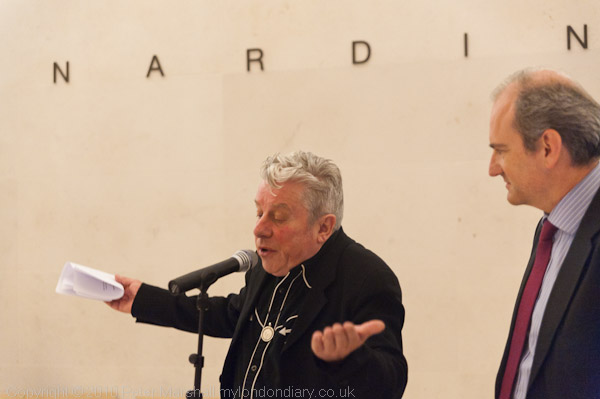
Brian speaking at the opening in Paris
Brian was the only kid in the area who passed his eleven plus; while everyone else went to the local Secondary Mod he went to Halesowen Technical School. But he had to leave and go out to work as soon as he was old enough. He was working in a factory in Lye when the foreman suggested he join the local camera club, and although he didn’t have any real interest in photography he did so. Three years later, after a girlfriend had left him, he wanted to escape from everything he knew and applied to photographic colleges as a full time student just to get away from Lye and everything he had known. Despite the fact that his pictures then were – as he says – “dreadful and displayed little talent” he was accepted.
The Black Country is an intensely personal project, inspired by the people that he knew in those early years and the experiences of life in Lye. Among those present at the opening was one of his oldest friends, a man from there, and during Brian’s speech they had a short exchange in the Black County dialect that would have defied most of the English speakers present, let alone the French.
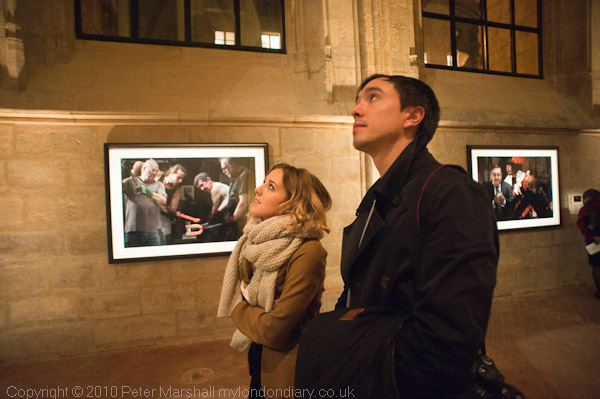
Brian’s assistant (right) at the Paris opening
Some of the people in the images, most of which were made on location, are from the Black Country, while a few others were carefully cast for studio portraits based on people he knew who are now dead. Brian works as a part of a team, and liberally acknowledged the contributions made to the project by his assistant, his stylist, printers and others.
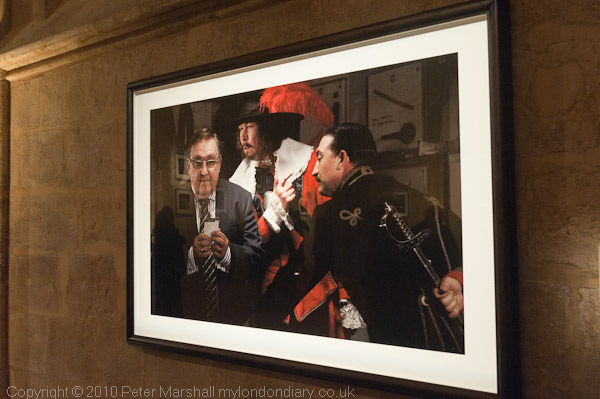
For me the strongest image was based on the Gunpowder Plot which fascinated the young Brian as the conspirators met just a few miles away and it’s mastermind, Robert Catesby was arrested not far away. The image was made in the Boro foundry where his father had his final job before retirement and the man on the left is Dennis Norton, the son of the man who employed him and who has now taken over as chairman and managing director of the firm. It’s a powerful and classic group image, based on a painting ‘Cardsharps’ by Caravaggio, with Catesby played by Steve Goldby, who has blogged about it, and the figure at the right is actor Callum Coates as the Earl Of Dudley, the landowner of much of the Black Country.
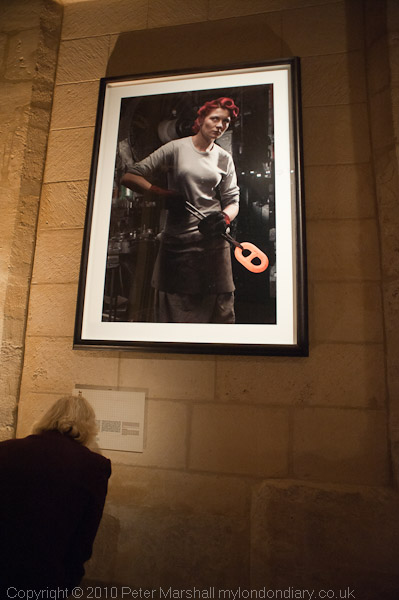
Another striking image shows a young woman as a foundry worker, holding a red hot chain link in tongs. The glowing link on her chain is echoed by a similar shape in her red hair, a small touch which really makes the image far more striking, and suggested by the stylist. The young woman was actually a worker in the factory, although not I think normally doing this particular job, and apparently before the shoot had always kept her hair combed straight down, but was rather taken by the effect.
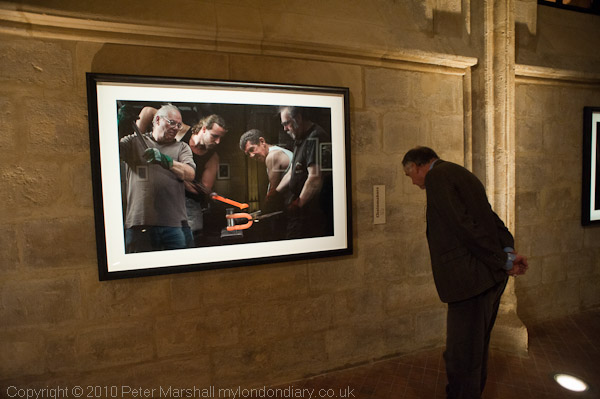
Another strong group image from the foundry shows a group of men making the chain. For me this show had a personal involvement by Brian that made it stronger than some of his other projects, but it also illuminated some of his earlier work. Included in the show were some of the portraits he made of workers at Broadgate shortly after the death of his father – and as he writes, “I photographed the men like knights lying in a cathedral with their swords.” His background (which in some respects is similar to my own) goes a long way to explain the empathy that he showed to the workers in his work on projects such as the Channel Tunnel rail link, and perhaps also a certain ruthlessness in some of his images of management.
You can see more pictures of the show and the opening on Facebook, and I’ll put more up on My London Diary shortly. In the meantime here are a couple more of my favourites from the opening. There were a couple of speeches in French, but as I expected Brian gave his usual fine performance, though parts of it proved tricky for his interpreter, and it was a more distinguished audience than most UK openings. I think this is his first major show in France (and he is one of those photographers who I think was entirely missing from Paris Photo) and it should do much to increase his reputation here.
I did find it slightly difficult to take photos holding a glass of champagne, though after several it seemed to get easier. The light level wasn’t too high in the sacristy, and I was glad I was using f2.8 lenses – the 20mm and Sigma 24-70 on the D700. Faster lenses wouldn’t have helped a great deal as most of the time I needed the depth of field, but it was good being able to work at ISO 3200 and know the results after processing would be fine. I did take a couple with flash as insurance, but the available light was so much better and of course less intrusive.
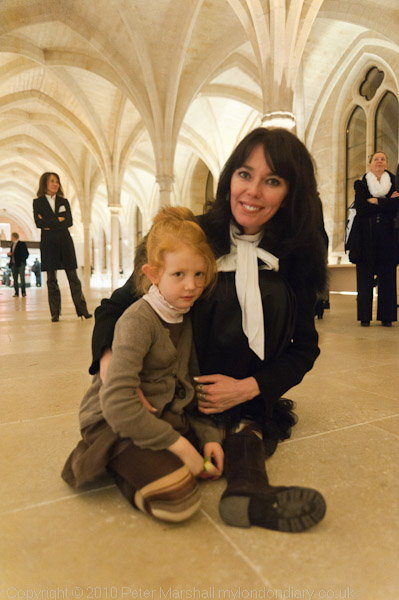

A little Black Country exchange
It was a very nice event, and a great show, and I was sorry to rather rush off when the official business was over (particularly as I could have had dinner) but Paris in November is a busy place and I had a party to attend!
More pictures on My London Diary.
[…] Griffin‘s Black Kingdom, work I have written about before when I attended the opening of his show of in Paris. You can see more pictures from that opening on My London Diary. Good though the work […]